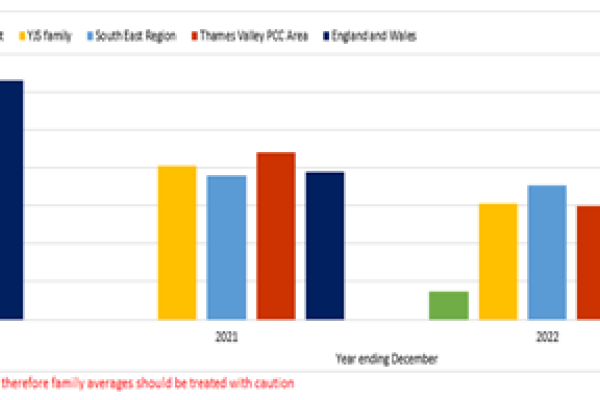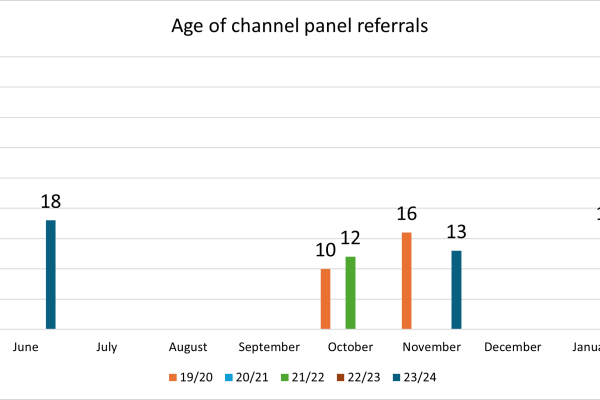In respect of children released under investigation and on police bail, data in this regard is being collected and will be presented to the Youth Justice Management Board for governance and scrutiny, including any data held regarding disproportionality. Any child who is released on these bases will be considered by all appropriate partners as part of a multi-agency meeting, for example, safeguarding or exploitation prevention.
Exploitation
While Bracknell Forest’s response to child exploitation is well-established, its recognition that risk of being exploited extends beyond 18, it is developing an all-age exploitation prevention strategy in 2024 which will be co-produced with those with lived experience.
A contextual safeguarding awareness campaign for children at risk of exploitation is currently being undertaken across 7 business sectors:
- banking
- hotels and accommodation
- public transport
- fast food
- retail
- taxis and private vehicles
- delivery services
146 individual children were discussed at Multi-Agency Child Exploitation (MACE) meetings and Makesafe Adolescent Panel (MAP) meetings. This is a small decrease from 150 children the year before. The Youth Justice Team work closely with the Exploitation Prevention service and are trained in the use of screening tools and their duties under the National Referral Mechanism.
Practice guidance relating to the assessment of children involved in elements of youth violence has been jointly developed between Exploitation Prevention and Youth Justice to share practice and approaches. It also uses material from across the sector including the Youth Justice Board, the Contextual Safeguarding Network as well as internal expertise of the different teams.
The MAP meets 3 times a month to triage adolescents that have been referred from Children’s Social Care, Youth Justice, Early Help or directly from schools. The meeting comprises operational managers from the Youth Justice Team, Makesafe, Targeted Youth Support Service, the Permanency Team and the Multi-agency Safeguarding Hub (MASH). The purpose of the meeting is to decide which service is best to lead on work with the young person in order to prevent work overlapping and make best use of resources.
Prevent
Prevention of radicalisation and extremist activity (known as Prevent) is also well-established in Bracknell Forest with a multi-agency Prevent Steering Group and Channel Panels. A new 3-year Prevent Strategy and Action Plan for 2024-27 was launched this year.
With reference to the Thames Valley Counter Terrorism Local Profile for 2023, key findings were:
- self-initiated terrorism remains the most likely form of terrorist attack in the UK - such an attack could relate to either Islamist terrorism or extreme right-wing terrorism and would likely involve low sophistication methods
- the proportion of under 18s being referred to Prevent in the Thames Valley continues to increase, rising to 59% in 2023 from 51% in 2022 - this trend has been seen regionally and across the UK and is expected to continue in 2024
- safeguarding initiatives across the board should be focused on online behaviour - resilience to grievance narratives continue to be necessary to help mitigate the risks associated with unsupervised online activity and the often ‘passive’ exposure to extremist content (such as exposure to material that has not been actively sought out)
- the most common cases were ‘vulnerability present but no ideology or counter terrorism risk’ (46%), ‘mixed/unclear/unstable/conflicted’ (26%) and ‘extreme right-wing terrorism’ (18% - an increase from 2022) - all 3 types accounted for 90% of cases (an increase from 58% in 2022) and each of these 3 categories featured in every local authority area within the Thames Valley
Bracknell Forest is a low demand and low risk area regarding the threat of active terrorism and continues to be designated as a Tier 3, non-priority area in the latest Counter-Terrorism Local Profile (2023).
2023 saw Bracknell Forest make 18 Prevent referrals to Counter Terrorism Police South-East. The referral sources were:
- education: 10
- police: 5
- prisons and probation: 1
- local authority: 2
The ideological concerns comprised:
- vulnerability present but no ideology or counter terrorism risk: 47%
- school massacre ideology: 6%
- mixed, unclear, unstable or conflicted ideology: 29%
- extreme right-wing terrorism: 16%
Of these 18 referrals, 4 were referred to Channel Panel for case management.
Referral sources were:
- education: 2
- local authority: 2
Ages were 13,15,16 and 18 years old.
Three of the 4 cases were closed to Channel after management and onward referral while 1 withdrew consent to receive support. This case was reviewed by the Police-Led Pannel but not adopted. All closed cases will have a 6 and 12-month review.
As per the graph below, Bracknell Forest has seen an increase in cases adopted by the Channel Panel over the last 5 years which is in line with Thames Valley and national trends. This is likely due to adopting more cases that don't quite reach Channel Panel thresholds initially so that partner consultation and local knowledge is incorporated into decision-making at that early stage to avoid missed opportunities.
Most referrals in Bracknell Forest comprise male children who are referred by the education sector.

